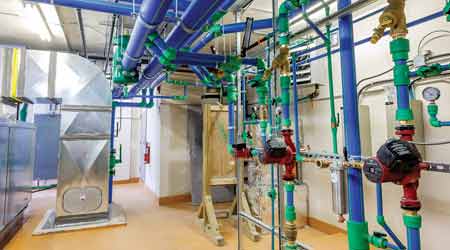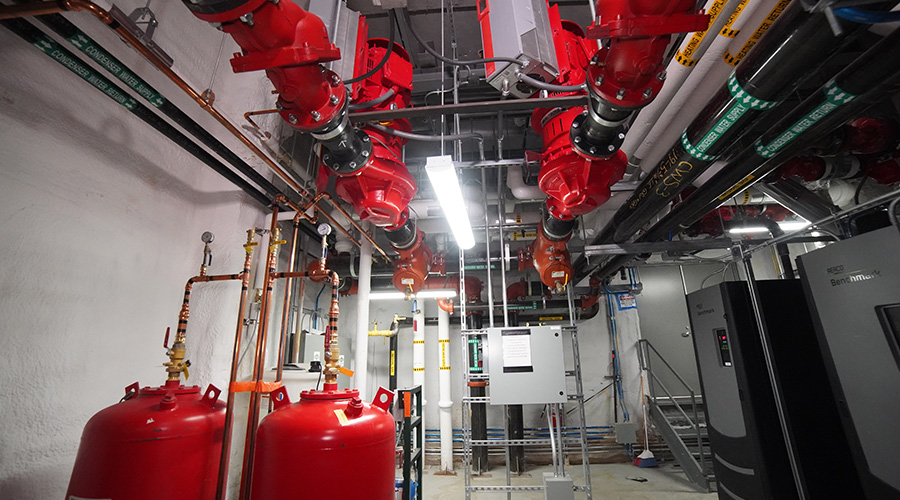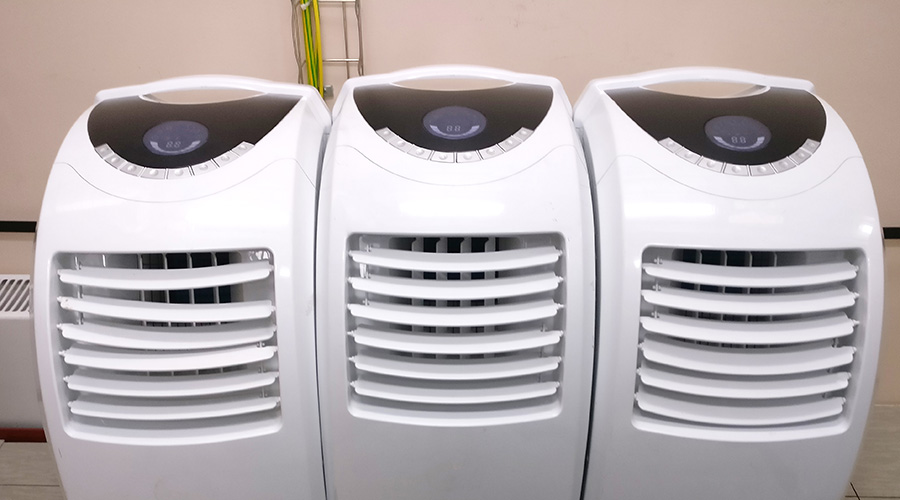 Plastic piping has a wide variety of uses, including chilled and hot water, potable water, and radiant heat systems.Aquatherm
Plastic piping has a wide variety of uses, including chilled and hot water, potable water, and radiant heat systems.AquathermThe Benefits of Using Plastic Piping
While the benefits of plastic piping are many, FMs also should keep in mind the limitations.
For many applications, plastic piping choices offer benefits that facility managers might want to consider.
One is cost. And because plastic piping is less rigid than metals, it can often be bent into a radius without the need for joints and couplers, usually reducing installation time.
With the exception of applications that require steam, plastic piping can also be used in all applications where metal is used, including potable water, radiant heat, and chilled water systems. As an additional benefit, because plastic piping doesn’t have the scrap value of copper, jobsite theft of piping is reduced.
Plastic piping technology can also be used in conjunction with metal systems to achieve the best performance properties of both materials. In other words, it’s not an all-or-nothing proposition.
In broad strokes, most plastic piping can handle water temperatures up to 180 F (CPVC will withstand temperatures to 200 F), and — because it is chemically inert — it is not susceptible to corrosion and oxidization. Scaling concerns and biofilm buildup are also less likely than with metal piping, making plastic an increasingly common choice for hospitals and other healthcare facilities. “PEX-a piping has fewer rougher surfaces than copper does,” says Aaron Stotko, commercial segment manager for Uponor, which manufactures PEXa tubing. “Biofilm always forms, but with less rough surfaces, and higher velocity potential than copper piping, this leads to a reduction of the formation of biofilm.” This becomes increasingly important for hospitals concerned with limiting airborne pathogens from water systems, such as Legionella, he says.
“[CPVC] piping systems also offer some of the best protection against biofilm and bacteria while withstanding ASHRAE disinfection guidelines without risk of damage,” Janowiak says.
According to plastic pipe manufacturers, fitting and installation time is faster and simpler than with metal and generally reduces installation time.
“I could make a pipe fitting in about 15 seconds,” says Uponor’s Stotko. “I could show you and then you could do it in the same amount of time.”
CPVC uses a solvent to connect piping; this “chemical weld” is stronger than metal welds, is faster, and — akin to all plastic piping — doesn’t require torches or other open flames.
Rehau’s Nickelson notes that because PEX can make directional changes without fittings, fewer connections are required. What’s more, the material’s elastic memory allows the use of cold-expansion fittings.
These compression-sleeve fitting systems, which require the installer to simply expand the pipe, insert the fitting into the pipe, then slide the compression sleeve over the pipe and fitting, are generally the strongest part of the system. Stotko notes that the fittings themselves can withstand pressures as high as 770 psi.
Compression fittings also give a secure fitting that can be visually inspected. “With copper and iron systems, you can’t be sure of the fittings until it’s pressure tested,” says Stotko.
With PP-R, there’s a torchless heat fusion process. The pipe and fitting bond on a molecular level. “So they are one material, and with [this] fusion, there is no open flame, no grinding of metal, and no VOCs released into the air,” says Campbell.
Some plastic piping manufacturers offer warranties. Stotko notes that his company’s PEXa pipes carry a 25-year warranty from the time that a certificate of occupancy is issued, or when the system using PEXa goes “live” in an existing building.
It’s also worth noting that most plastic piping manufacturers print on the exterior of their tubing the salient performance characteristics that installers need to know. These design specifications list pressure limits at specific temperatures, as well as manufacturing information that usually contains date codes, lot numbers, and more.
Understanding limitations
Plastic piping isn’t without limitations. As already noted, the temperature ratings on all plastic pipe choices are at or below 200 F, precluding its use for steam applications.
In some instances, piping diameter is limited. And plastic piping, which often doesn’t require the corrosion inhibiting chemicals that metal pipes do, is susceptible to other kinds of damage.
“PP-R is non-reactive with many chemicals, but chemical compatibility also depends on concentration and temperature,” says Campbell. “When using PP-R for domestic hot water applications where copper is also in the system, there are several design considerations that must be adhered to.”
But Campbell further notes — as does every plastic piping manufacturer contacted for this article — that piping companies can help facility managers identify applications in which their piping will work, and those where it will not. Campbell also notes that the Plastics Pipe Institute can assist engineers who are designing hybrid plastic and metal piping systems.
Janowiak notes that, because CPVC is manufactured with chlorine, it’s not susceptible to chlorinated water, which can sometimes be an issue with metal piping. However, it is susceptible to other chemicals. “CPVC has a chemical makeup that may react and respond to other materials that touch it, such as insulation, fire-stopping materials, and caulk; these could potentially contain substances that weaken CPVC,” he says.
UV degradation is another concern common to all plastic piping choices. This not only limits plastic piping to indoor applications, but it also means that installation teams should not leave plastic piping on the jobsite where it is exposed to sunlight.
In the case of PEX, Rehau’s Nickelson notes that it is susceptible to certain types of chemicals, such as petroleum-based products.
Plastic piping is less rigid than metal, and that fact can be both a benefit and a limitation. More flexibility in the line requires more fasteners to keep the line in place when compared to metal systems. This flexibility means that the piping can also physically move more than metal pipes when not secured or fastened properly, particularly in applications with abrupt changes in flow volume or velocity. It’s not quite water hammer as commonly known with metal piping, but it is a consideration for designers and installers.
Another consideration is expansion and contraction, as with all building materials. Janowiak notes that CPVC pipe materials will expand when heated and contract when cooled, and engineers must factor this into the system’s design.
“The effects of expansion can be controlled with changes in direction, so an offset or loop may be required on a long, straight run, but expansion loop requirements for CPVC are not much different than those of properly designed copper systems,” he says.
Metal and plastic piping each have benefits and limitations. As with most projects, finding a trusted manufacturer, engineering design firm, and building contractor means that facility managers can pick from the best attributes of any piping material to meet their organizations’ needs.
Loren Snyder, a contributing editor for Building Operating Management, is a writer who specializes in facility issues. He was formerly managing editor of Building Operating Management.
Email comments to edward.sullivan@tradepress.com.
Related Topics:













